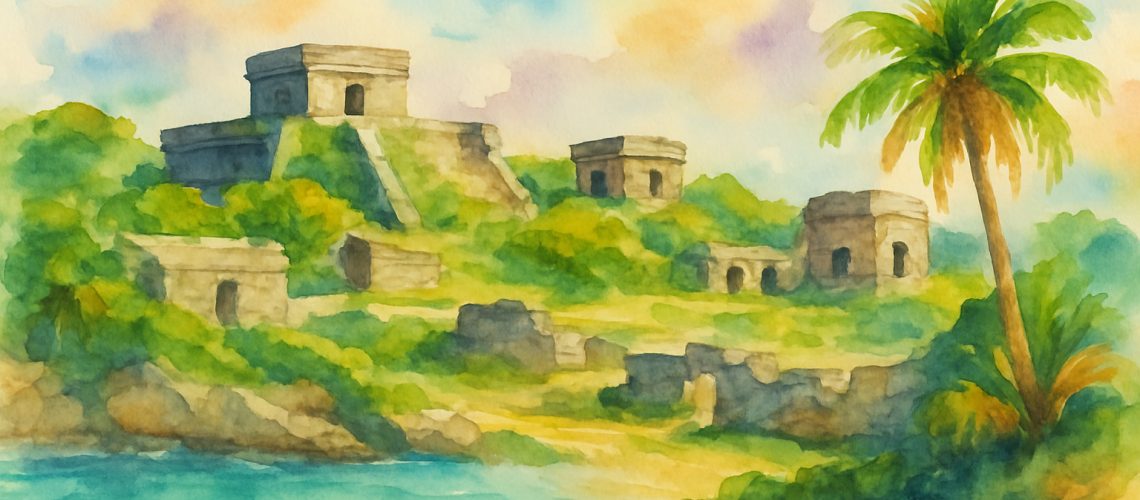Unveiling Tulum: The Ancient Maya Fortress by the Sea
Imagine walking through the remnants of a once-thriving city, where the echoes of the past resonate with every step. Tulum, perched on the scenic eastern coastline of Quintana Roo in the Riviera Maya, represents just that — a breathtaking window into Maya history that captivates the imagination. This ancient fortified city flourished primarily from the 13th to the 16th century, showcasing stunning architecture typical of the Post-Classic period. Iconic structures like El Castillo and the Temple of the Frescoes stand as testaments to the artistry of the Maya, adorned with intricate murals that have withstood the test of time.
Serving as a vital maritime port and a commercial hub, Tulum was a bustling nexus where vibrant trade routes converged. Here, precious goods such as jade, copper, and ceramics were exchanged, linking this coastal marvel to other Mesoamerican civilizations. The strategic position of Tulum offered both economic prosperity and security, making it a focal point within the Maya world.
A City of Light: The Origins of Tulum
Originally known as Zamá, meaning “dawn,” Tulum was not only a commercial powerhouse but also a center of religious and political significance. The city was fortified with imposing walls, delineating the domains of the ruling elite and the priesthood. At its peak during the 13th and 14th centuries, Tulum thrived as a cultural and spiritual beacon, attracting residents and visitors alike.
The Decline: A Tragic Turn of Events
However, the arrival of Spanish conquerors in the 16th century marked the beginning of Tulum’s decline. The introduction of new diseases and the ensuing conflicts devastated the indigenous population, leading to the city’s abandonment. The once-bustling streets fell silent as the Maya disappeared from their homeland, leaving only whispers of their achievements.
Exploring the Depths of History
Research suggests that Tulum was not the first civilization to inhabit this location; evidence indicates that humans resided in the area as far back as 9,000 years ago. Artifacts, including skeletal remains found in nearby cave systems, tell a different story of a land rich in history long before the Maya established dominance.
A Modern-Day Wonder
Today, Tulum’s ruins stand as a significant tourist attraction, pulling visitors from across the globe to experience the unique blend of history, architecture, and nature. The stunning coastal views combined with the striking remnants of the past provide an unparalleled backdrop, inviting exploration and reflection. As you wander through the ancient pathways, the air brims with stories waiting to be uncovered, making Tulum a true gem of the Riviera Maya.
Are you ready to embark on a journey through time? Whether you’re an avid history buff or simply looking to connect with nature, Tulum offers an unforgettable experience that transcends generations. The mystical allure of this ancient site awaits you!
Summary
In summary, Tulum presents an extraordinary glimpse into the Maya civilization, combining history, architecture, and stunning coastal beauty. As an ancient city that thrived for centuries, it became a vital trading hub and spiritual center, once flourishing with life. The arrival of the Spanish conquerors, however, marked a tragic endpoint for the city, leading to its abandonment. With archaeological evidence revealing even earlier settlements, Tulum’s rich tapestry draws tourists eager to explore its remnants. Don’t miss the chance to be part of this captivating journey into the heart of an ancient world. Experience Tulum for yourself, and let its stories inspire you to discover the secrets of the past!
Frequently Asked Questions
What is the historical significance of Tulum?
Tulum is an ancient Maya city that served as a vital commercial port, connecting land and sea trade routes. It showcases impressive Post-Classic architecture and significant cultural heritage.
How can I visit the Tulum ruins?
Visitors can explore Tulum by purchasing tickets online or at the entrance. Guided tours are also available for those seeking in-depth knowledge about the site.
Are there any health precautions I should take when visiting?
It is advisable to stay hydrated, wear sunscreen, and protect oneself from insects while exploring the outdoor ruins, especially during warmer months.













